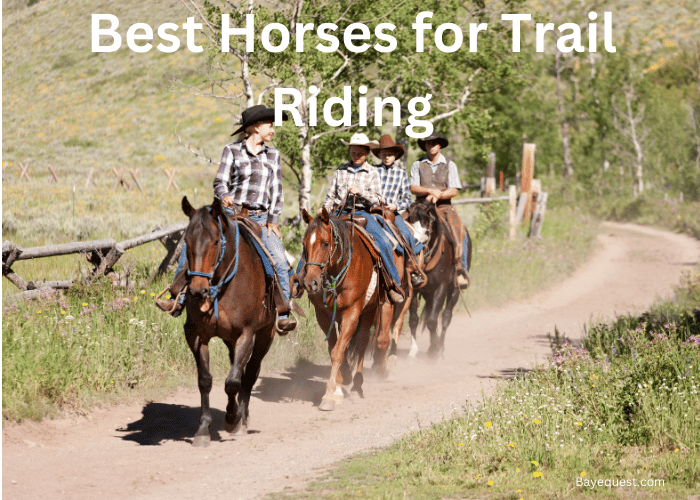Did you know that not all horses are suited for trail riding? With years of equine experience, we understand the unique challenges trail riders face.
Selecting the right horse is crucial for a safe, enjoyable journey. This article will guide you through choosing the best horses for trail riding, addressing common concerns like temperament and endurance.
Whether you’re a novice or seasoned rider, our insights will ensure you make an informed decision. Let’s embark on this adventure together.
Best Horses for Trail Riding: Key Takeaway
The best horse breeds for trail riding are:
- American Quarter Horse
- Appaloosas
- Tennessee Walking Horse
- Missouri Fox Trotter
- Arabian
- American Paint Horse
- American Saddlebred
- Gypsy Vanner
- Icelandic Horse
- Mustang
- Paso Fino
- Irish Cob
- Old Kentucky Saddler
- Peruvian Horse
- Rocky Mountain Horse
- Tennessee Walking Horse
- Thoroughbred
What Makes a Great Trail Horse?
Unfortunately, you cannot recognize great trail-riding horses by merely looking at them. Instead, you must spend time with the horse to determine whether they’re the right one for your expeditions.
Nonetheless, the best trail horses often exhibit a few common trains. For instance, you want a social companion who gets along with other horses.
Furthermore, the horse must be willing to go over, under, or around obstacles and jump only when necessary.
In addition, consider the following traits;
- Patience
- Low flight response
- Easily adapts to new surroundings
- Likes to travel long distances
- Willing to drink any water available
16 Best Breed of Horses for Trail Riding
The best trail horse breeds are hardy, athletic breeds that excel in harsh environments. They are also big and strong for back riding, with a smooth gait for comfort. The following eleven breeds tick all these boxes.
1. American Quarter Horse
The American Quarter Horse is the most popular horse in the US because it’s an extremely versatile breed that excels in nearly any discipline.
But what makes it a great trail-riding breed? There are many reasons. First, the quarter horse is the perfect size for the average rider.
At 15 hands (14-16 on average), you can climb and handle the quarter horse with little trouble.
Next, quarters are strong, stocky horses with great balance that helps them over obstacles and unnatural terrain. Additionally, their compact bodies are perfect for back riding on rough terrain. They’re also extremely agile.
Above all, the American quarter horse is an intelligent, sure-footed expert who gracefully navigates rough terrain without greatly discomforting the rider.
And if something goes amiss, their level-headed and easy-going nature guarantees maximum cooperation.
You can find quarter horses in various colors, from traditional bay to black, gray, and patterned coats. The American quarter horse prices start at $3,000.
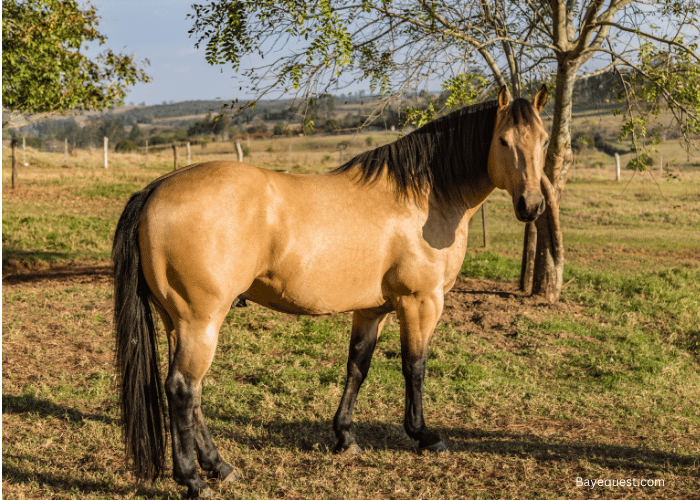
2. Appaloosas
The Appaloosa is the next-best trailing horse if you’re not a big fan of the American Quarter horse. They’re almost the same height, with appaloosas only about 0.1 hands taller on average.
However, the appaloosa has a longer, more athletic body. Furthermore, Appaloosas are exclusively patterned.
Trail riders mainly adore the Appaloosa for its “wild” origins. Though they’ve been domesticated for years, Appaloosas were originally wild horses roaming the wild.
It was only in the 16th century that a few native US tribes domesticated them for carriage and farm work.
Later, breeders refined the bloodlines, crossing them with Thoroughbreds and Arabians to produce strong, hardy, spotted horses.
The “wild horse” heritage means trailing is in their genes. They’re accustomed to harsh weather, especially desert-like conditions.
They can travel long distances with no qualms. Their bravery is another trait that rarely goes unnoticed. They’re also calm in new environments.
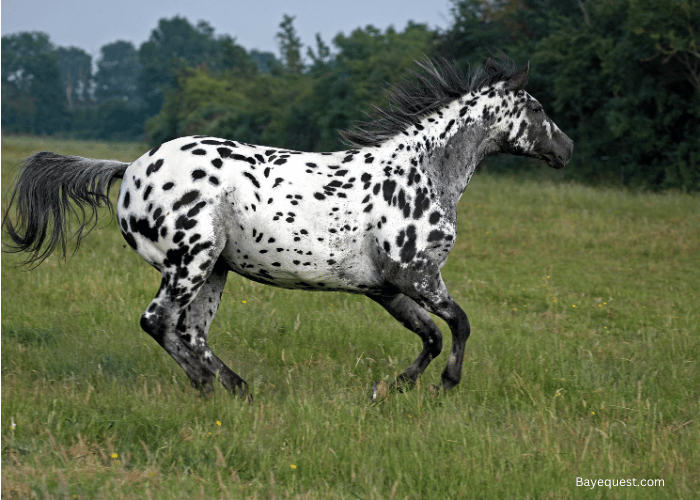
3. Tennessee Walking Horse
The Tennessee walking horse is famous for its unique, comfortable gait. The horses can perform a flat-foot walk, running walk, or canter, each graceful and pleasing.
Additionally, they can perform the rack, fox trots, single-foot, and stepping pace walks.
Alternatively, for trail lovers, the walker has a unique trail pleasure walk in its arsenal. Also known as the dog walk, it’s a smooth, highly relaxing four-beat gait, perfect for a walk in the woods. It’s performed on a loose rein.
The smooth gaits make trail riding more fun, with less pain. There’s also less risk of losing balance if you’re a newbie.
Besides the smooth gait, Tennessee walkers make great trail horses for their intelligence and physical attributes. On average, they’re 15.2 hands tall, with large shoulders and short backs.
Moreover, they’re strong horses unfazed by difficult landscapes and easy-going companions keen to please the master.
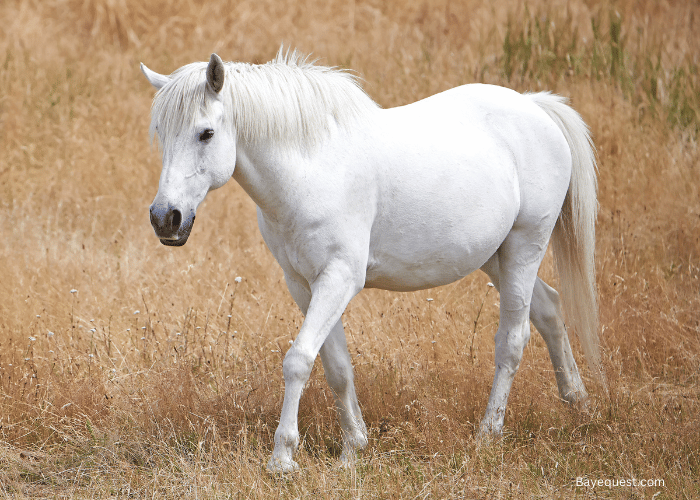
4. Missouri Fox Trotter
The fox trotter is another gaited horse with majestic comfortable, alluring movement. It’s about the same size as the walker, with most stallions maturing at 15 hands.
The main difference is that Tennessee walkers mainly perform the running walk, while the fox trotter is famous for the fox trot.
A fox trot looks like the horse is running in the front and walking in the back. The Missouri fox trotter can also perform the “fox walk,” a smoother version of the trot.
The comfortable gait is the first major advantage when trailing riding with your trotter. The topline doesn’t move much when the horse walks. (Find out how to build the topline of a horse for better riding)
Better still, the fox trotter can accelerate effortlessly and travel longer without showing signs of tiring.
Above all, fox trotters are among the most trustworthy trail-riding horses, hence frequented by forest rangers.
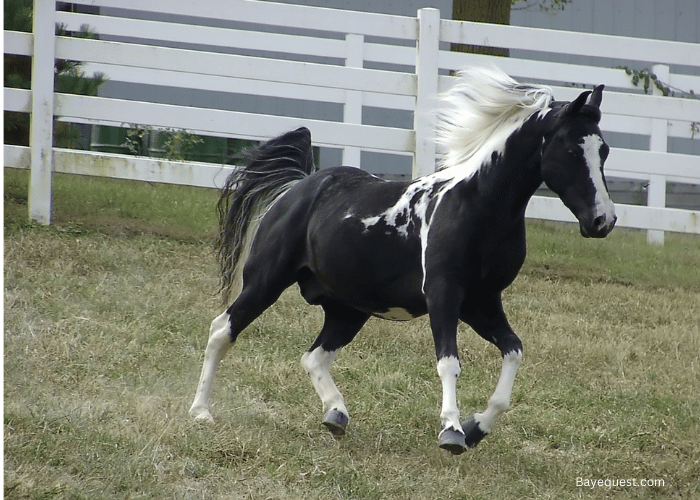
5. Arabian horse
Arabians are among the most famous horses. They are strikingly beautiful horses, and their pedigree in equine events and contests is undoubted.
Unfortunately, they remain a pipedream for most enthusiasts as they cost a pretty penny.
One reason they’re so valuable is their versatility. Arabians excel in nearly every discipline, from dressage and racing to trail riding. They’re also strong horses that conquer many farm duties with ease.
However, their resilience is the reason they are the best trail horses. First, the Arabian horse originates from the hot, dry Arabian Peninsula.
So, it’s bred for harsh conditions. Additionally, horses can survive on little food and water, making them the perfect companions on long travels.
Finally, Arabians are top of the list if you’re looking for an intelligent horse. They learn and adapt to new environments quickly and easily find ways around obstacles.
Read also: Arabian Horse Price.
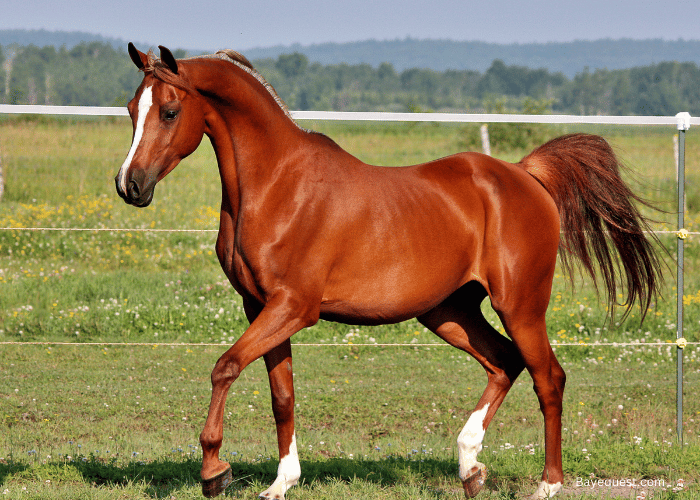
6. American Paint Horse
Also known as the “paint,” the American Paint Horse is a gorgeous Western stock breed with a distinctive, colorful coat pattern. The average-sized horses stand at 14 to 16 hands tall, maturing at 950 to 1200 pounds.
They are most famous for their colorful coats. Indeed, no two paint horses are the same. However, tobiano, overo, and tovero patterns are the most common. All patterns include significant white patches, mainly on the face and legs.
So, what makes them great trail riders? Well, a few things. First, paint horses are strong and well-balanced, with powerful hindquarters. These physical characteristics allow them to conquer any terrain.
Paints are gentle, easy-going horses, happy to follow instructions. They’re also adventurous horses that enjoy the thrills of the wild. Bring along some water to keep the horse hydrated.
Read also: How Much Do American Paint Horses Cost?
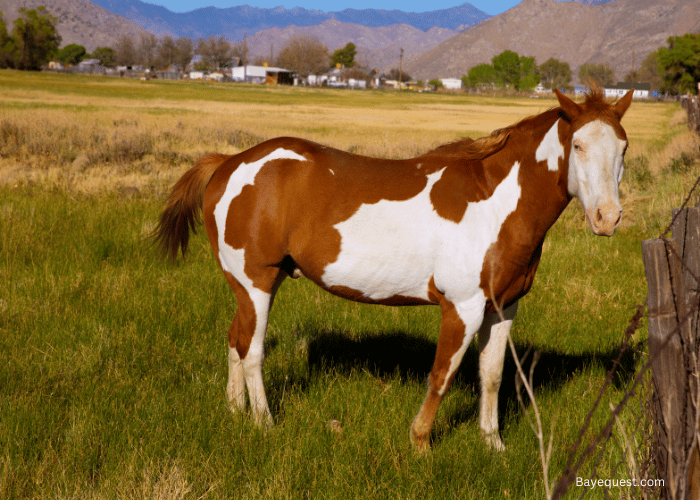
7. American Saddlebred
Few horses have a richer history than the Saddlebred. It starts with Hobbies and Galloways arriving from Britain, then meanders through centuries of crossing the two breeds to produce Narraganset Pacers.
Then, the pacers are crossed with thoroughbreds to produce American Saddlebreds.
However, the Saddlebred has been refined over the years to produce more adaptable breeds. Thus, today, the Saddlebred horse is a highly versatile horse that fits many equestrian disciplines.
The standard Saddleback is 15-17 hands, with a strong, short back, highly refined head, and chiseled, smooth jawline. The slightly arched necks give them a clean look.
All these qualities make it a beautiful horse to bring on your trailing quests. But more importantly, Saddlebreds are even-tempered, easy-keepers willing to learn new skills.
Therefore, you don’t have to worry about encountering new challenges.
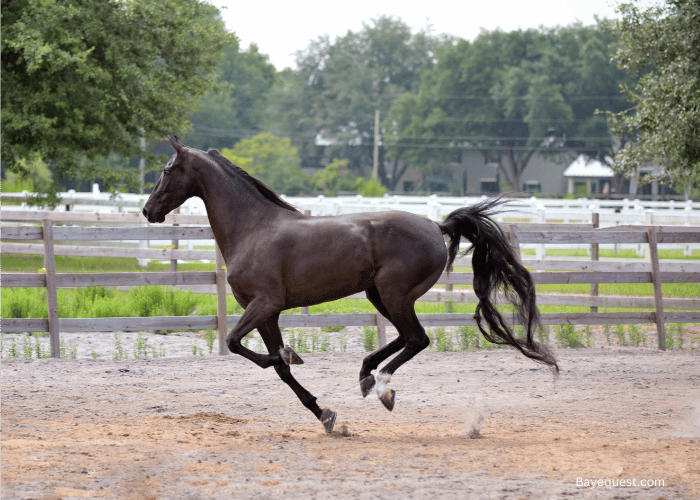
8. Gypsy Vanner
The Gypsy Vanner is a descendant of famous draft horses, including the Shire and Clydesdale. It’s mostly a solid-colored breed, though patterns such as tobiano, skewbald, and Blagdon are common.
But what stands out most about their looks are their feathery knees, hocks, and full manes and tails.
Mature stallions stand 12 to 15 hands tall and weigh 1,000 to 1,700 pounds. So, you can already visualize a stocky horse.
Though shorter than a regular draft horse, they’re broadly built with muscular shoulders and strong hindquarters.
These qualities make Gypsy Vanner horses ideal for pulling caravans and carriages. They’re also excellent riding horses and excel in various ring events, including dressage sports.
But most importantly, they’re great trail riders. Their physical attributes and laid-back temperament make them friendly but capable companions who thrive in difficult terrain.
Read also: Gypsy Horse Lifespan and Characteristics.
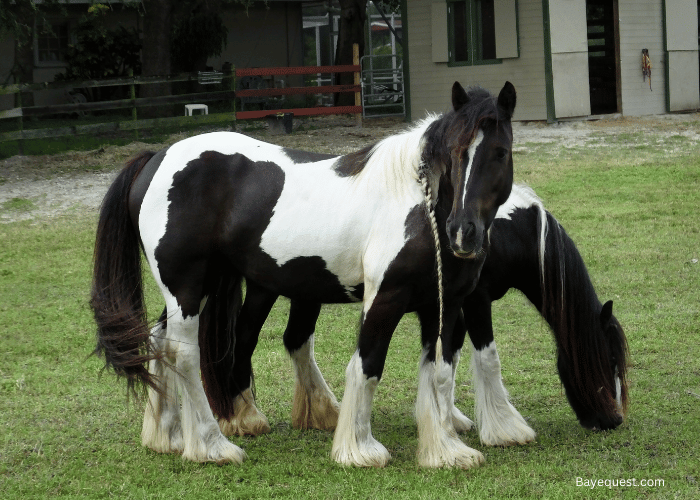
9. Icelandic Horse
The Icelandic pony is an excellent choice if you’re shopping for a shorter horse for personal reasons. The breed averages 13.2 hands, with short legs and a stout body. The necks are short and broad, while the withers are low.
Unsurprisingly, they’re strong. Moreover, their stocky build allows Icelandic horses to carry full-grown adults. We also love their heavy coats. It allows the ponies to withstand cold weather.
But beware that Icelandic horses are best suited for colder regions. So, consider alternative options if you live in a predominantly warm state.
That said, Icelandic horses are friendly and easy to keep. But more importantly, they are great with kids. So, it’s a great choice for traveling with the family.
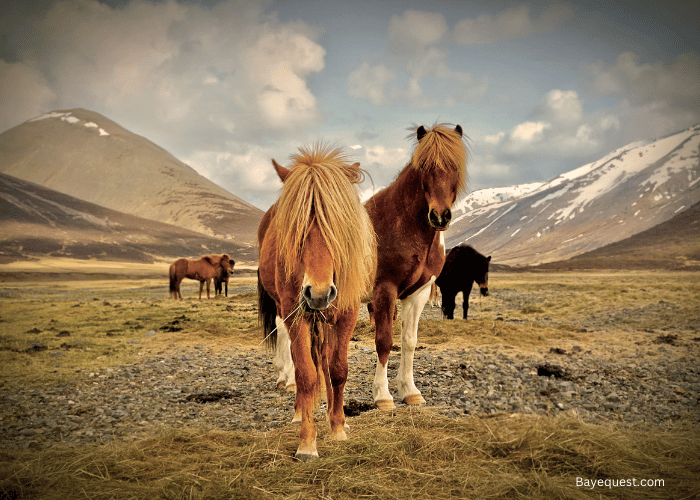
10. Mustang
We wouldn’t recommend Mustangs for beginners and kids. But they’re among the best horses for trailing if you’re an experienced professional.
They’re so familiar with roaming the forests that walking down a bridle path gives them an adrenaline rush.
Mustangs are hardy horses that enjoy foraging independently, relying on shrubs and local greeneries to replenish their energy. Similarly, they rehydrate infrequently, sometimes going a whole day without drinking water.
But that’s just the start. Mustangs are average-size horses comfortable for the normal rider. Some stallions reach 16 hands tall. But most mature at 12 to 14 hands.
The backs are short, with rounded croups for greater comfort.
The best part is that you can acquire a mature Mustang with basic training from the Bureau of Land Management (BLM) for as little as $125.
Read also: Bronco Vs Mustang Horses.
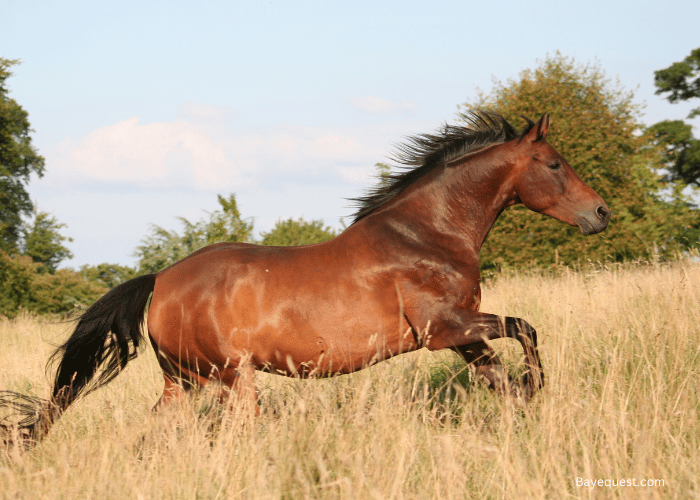
11. Paso Fino
Paso Finos are gaited horses originating from South America, where the name loosely translates to “fine step.” They’re primarily trail-riding horses. However, you can also train the horse shows and events.
So, why do they make fine trailing horses? First, they’re gorgeous. The majority are bay, with brown bodies and black points on the mane, tail, and legs.
Alternatively, you can opt for chestnut colors with various shades of red. Their eyes are just as beautiful, typically with a bright yellow or orange iris.
Next, the Paso Fino is a mid-sized horse with a gentle temperament. Adults mature at 13 to 15 hands and are amiable and highly trainable.
The horses can perform three gaits: the classic Paso Fino, the Paso Corto, and the Paso Largo. In each gait, the feet contact the ground independently in a precise, unbroken rhythm.
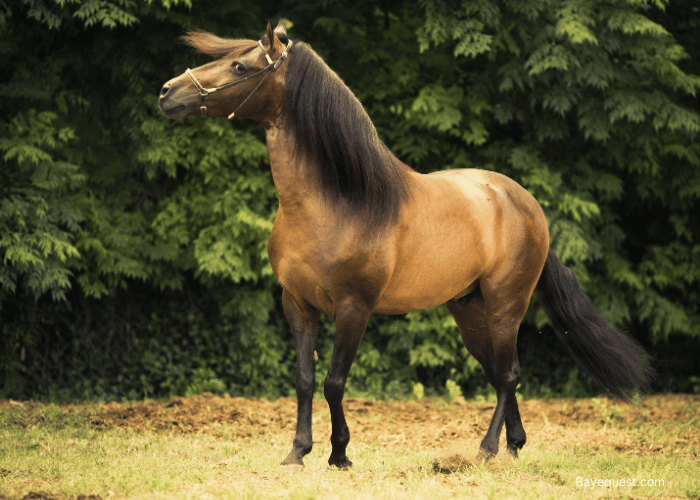
12. Irish Cob
The Irish Cob is like your sturdy friend who’s always there when you need them. This horse is known for being strong and dependable.
It’s got a thick build and feathered legs, making it stand out in a crowd. Irish Cob horses are calm, which means they’re great for a relaxed ride through the trails.
If you want a horse that’s both solid and gentle, this is your go-to.
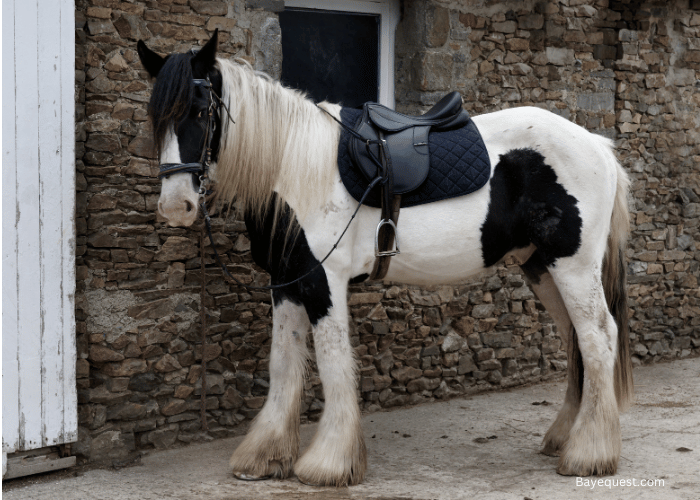
13. Old Kentucky Saddler
The Old Kentucky Saddler is the smooth operator of the horse world. It has a smooth gait that feels like gliding, making long rides feel like a breeze.
These horses have a friendly, willing attitude, making them easy to bond with. They’ve got a bit of history, too, bringing that old-time charm to your trail adventures.
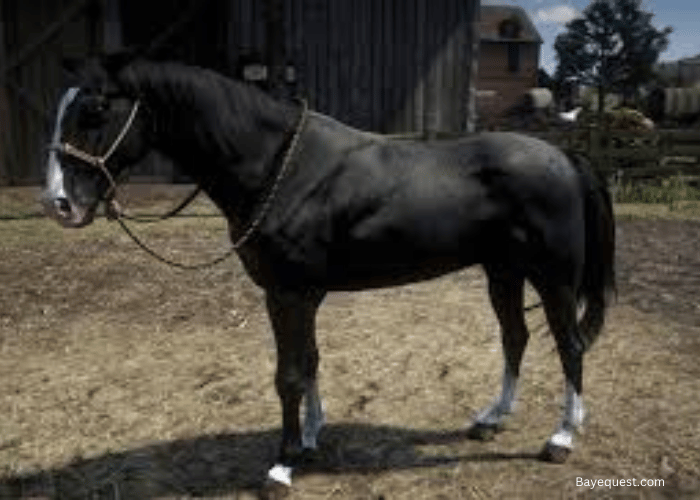
14. Peruvian Horse
Now, the Peruvian Horse is the dancer. It’s known for a special gait called the Paso Llano, which is super smooth. Riding a Peruvian feels like being on a floating cushion.
They’re elegant and have a proud look, making your trail rides comfortable and stylish. If you like a bit of flair with your comfort, the Peruvian is the horse for you.
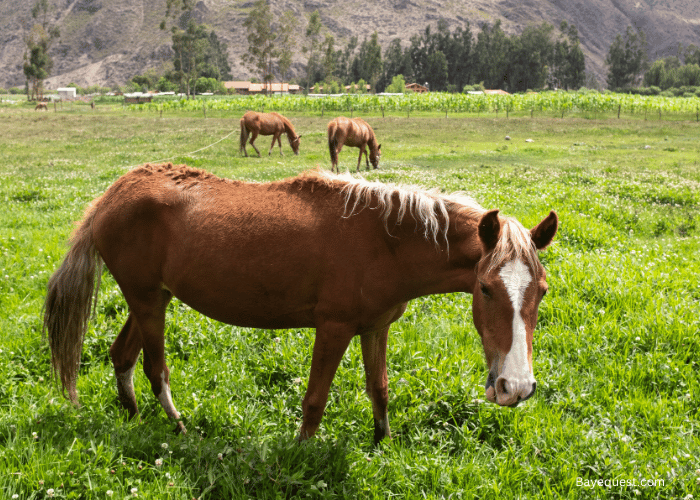
15. Rocky Mountain Horse
The Rocky Mountain Horse is like your reliable SUV. It’s got a natural, easy-going gait that’s perfect for all kinds of trails. These horses are known for their steady temperament and surefootedness.
They’re great for beginners and experienced riders, making every trail ride feel safe and enjoyable. Plus, their chocolate coat with a flaxen mane and tail looks pretty stunning too.
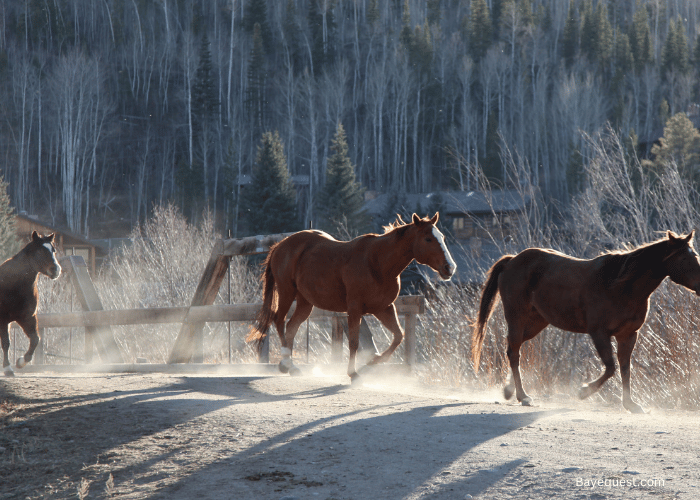
16. Thoroughbred
Thoroughbreds are like the sports cars of the horse world. They’re known for their speed and agility. While they’re often seen on the racetrack, many Thoroughbreds also make excellent trail horses.
They’re athletic and have a lot of energy, so they’re great for those who love a bit of excitement on their rides. If you want a horse with some zip and spirit, a Thoroughbred might just be your perfect trail partner.
See also: Quarter Horse Vs Thoroughbred.
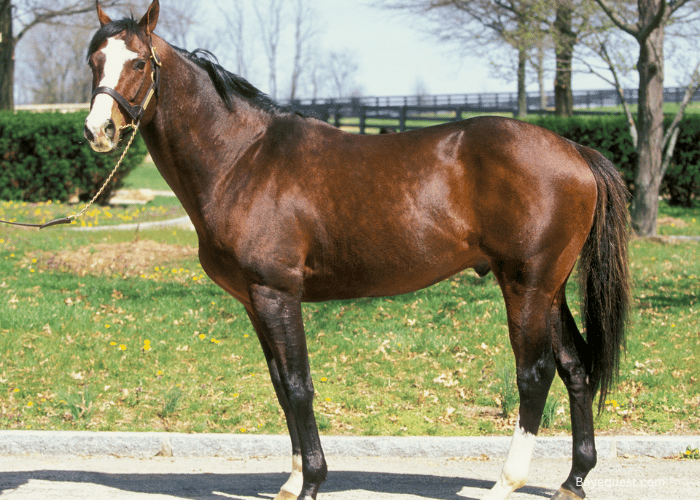
FAQs
What’s the best horse for long-distance riding?
The Arabian is widely considered the best trailing horse, thanks to the breed’s stamina and exceptional endurance. Arabians are accustomed to challenging environments and difficult terrain. Moreover, they can walk long distances without feeding or rehydrating. However, the American quarter and paint horses are wonderful alternatives if you can’t find an Arabian.
Are friesian horses good for trailing riding?
Yes, the Friesian horse is an exceptional trail-riding horse. It’s an esteemed breed almost reserved for the dressage arena, where it showcases its natural talent and classical elegance. Nevertheless, a calm demeanor and enviable strength make Friesians worthy friends on trailing expeditions.
What’s the best horse for trick riding?
No specific horse is built for trick riding. However, Trixie Chicks prefer the American quarter horse for the breed’s disposition. The quarter’s stocky build comfortably holds the rider’s weight. Moreover, quarter horses can reach incredible top speeds over short distances.
Best Trail Riding Horses: Conclusion
Arabian horses are the best trail-riding horses if you can find one. Their high endurance and adaptability make them the perfect companions on a trailing adventure.
However, consider the American quarter horse if the Arabian’s high price tag exceeds your budget. Paints and the Missouri Fox Trotter are also wonderful trailing companions.
Next, check out our article on the lifespan of a quarter horse and learn how to care for them and maximize their years on the trail.




